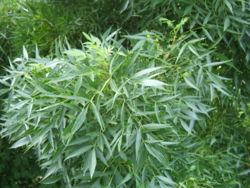| Fraxinus angustifolia | |
|---|---|
 | |
| Foliage of subsp. oxycarpa | |
| Scientific classification | |
| Kingdom: | Plantae |
| Clade: | Tracheophytes |
| Clade: | Angiosperms |
| Clade: | Eudicots |
| Clade: | Asterids |
| Order: | Lamiales |
| Family: | Oleaceae |
| Genus: | Fraxinus |
| Section: | Fraxinus sect. Fraxinus |
| Species: | F. angustifolia |
| Binomial name | |
| Fraxinus angustifolia | |
 | |
| Distribution map | |
| Synonyms | |

Fraxinus angustifolia, the narrow-leaved ash, is a species of Fraxinus native to Central Europe and Southern Europe, Northwest Africa, and Southwest Asia. [1] [2]





